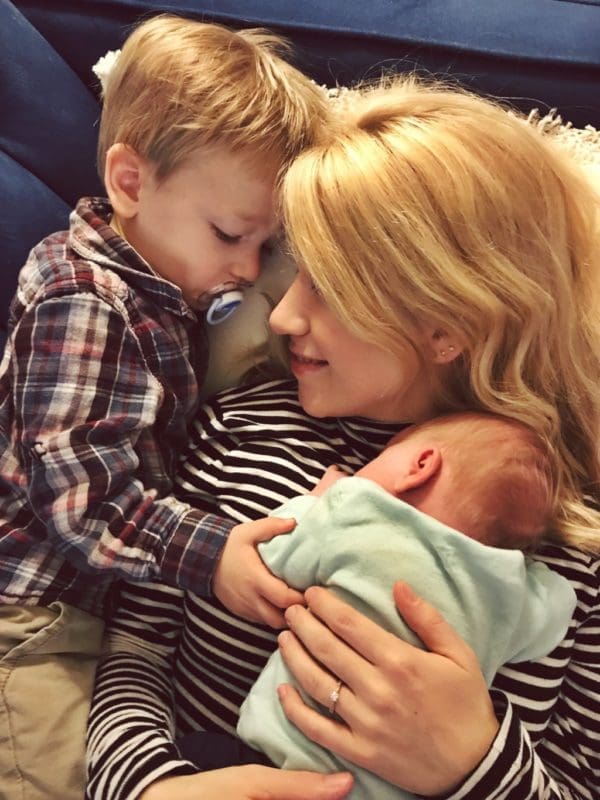Our scars tell the stories of how we healed from wounds. The pink C-section scar that droops below my hip bones tells the story of my son’s difficult birth. His entrance into the world is woven through my body.
My scar reminds me of one of the sweetest gifts I have ever received: my amazing son, Henry. My scar also reminds me of the obstacles I overcame to bring him into this world. I endured life-threatening complications following my C-section that led to a painful recovery filled with infections, countless CT scans, tubes through my body, lung problems, and acute kidney failure. I know what it’s like when your birth almost kills you.

About two years after my C-section, I was due with my second child. I was faced with a decision that terrified me: do I want to try for a VBAC (vaginal birth after cesarean) or schedule a repeat C-section? There are risks associated with both options. One of the primary risks associated with a VBAC is uterine rupture (meaning your uterine scar ruptures during labor), which is sometimes the risk factor that deters people from a VBAC even though the risk is extremely low (less than 1%). C-sections are major surgery and carry the risks associated with surgery: hemorrhaging, infections, and higher maternal mortality rates. After a long process of research as well as my own journey of working through my anxieties around giving birth again, I decided to try for a VBAC.
As the late-fall sunshine poured into my hospital room on the morning of November 26, 2018, I gave birth to my daughter, Evelyn. I will always remember the happiest tears that filled my eyes as I felt her on my chest for the first time. Her birth was a beautifully redemptive VBAC.

April is Cesarean Awareness Month and I want to affirm the life-saving power of C-sections while also sharing about the problematic overuse of them. In 1965, the U.S. C-section rate was just under 5%; in 2017, it was 32%. The World Health Organization states that when the C-section “rate goes above 10%, there is no evidence that mortality rates improve” so it’s clear that a high C-section rate does not correlate to saving the lives of mothers and babies. In the in-depth NPR and Pro-Publica report Lost Mothers: Maternal Mortality in the U.S., they reported that “[m]ore American women are dying of pregnancy-related complications than any other developed country.” And according to The New York Times, “complications linked to surgical deliveries are among the biggest factors” contributing to the high maternal mortality rate. The facts speak for themselves: we’re subjecting many mothers to unnecessary abdominal surgery and it’s harming us.
If you’ve had a prior C-section and are debating whether or not to schedule a repeat C-section or try for a VBAC, here would be my suggestions for you:
First, educate yourself.
No matter which birth route you choose, you deserve to know the risks and benefits of your options. Both a repeat C-section and a VBAC can be reasonable options. The American College of Obstetrics and Gynecology “states that attempting a VBAC is a safe and appropriate choice for most women who have had a prior cesarean delivery, including some women who have had two previous cesareans.”
Second, do what you can to stack the cards in your favor.
If you decide to have a C-section, there are many decisions you can make ahead of time about how it will go. You can choose to have a clear drape if you want to see your baby right away. You can choose the music playing in the operating room. And you can request to have skin to skin with your baby while you’re being stitched up.
If you decide to try for a VBAC, I highly recommend finding a supportive provider. I decided to switch to a new provider who was very supportive of VBACs and had a 90% success rate with them. I also hired a doula, practiced prenatal yoga, ate well, walked a lot, and talked to some close friends about my anxieties. While there are many aspects of birth we can’t control, we can make purposeful decisions to hopefully lead to a more positive and healthy birth experience.
Third, consider your future fertility.
My husband and I have always wanted to have a big family if we are able to, and I knew that risks from C-sections go up with each surgery. That’s not to say you can’t have a big family and have multiple C-sections, just that they do get a little riskier each time. Placental complications like previa and accreta increase each time you have a C-section. For me, the risk of placental complications in a future pregnancy felt more concerning than the very low risk of uterine rupture that accompanies a VBAC.
Lastly, tap into your intuition.
I know this may sound a little woo-woo, but I believe that sometimes we know in our gut what decision we want to make, but we feel too afraid of outside pressures or judgment to make it. Ask yourself the obvious but often unconsidered question: what do I want to do? Other sources can tell you about the risks and benefits, statistics and stories, but only you can say what you want. Once you can picture the type of birth you desire, try to discern why that’s important to you. Knowing your why will give you confidence as you prepare to birth your baby.
If you’ve had a C-section, how did you feel about it? How did you go about deciding whether or not to have a repeat C-section or a try for a VBAC for your next child?

